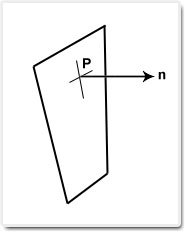
Ax + By + Cz + D = 0
Where (A,B,C) is the unit normal, and (x,y,z) is a point on the plane.
To solve for D we rewrite the equation as:
D = -(Ax + By + Cz)
So my point (x,y,z) equals (0,0,0)
Substituting we have:
D = -(A*0 + B*0 + C*0)
So, D = 0
For any given vertex (Vx,Vy,Vz) the equation becomes:
Side = AVx + BVy + CVz + D
If Side is greater than zero, then the vertex lies on the same side as the normal.
If Side is less than zero, then the vertex lies on the other side of the normal.
If Size is zero, then the vertex lies on the plane.
So to define the three planes along each axis we have:
(A,B,C) = (1,0,0)
(A,B,C) = (0,1,0)
(A,B,C) = (0,0,1)
To test a given vertex (Vx,Vy,Vz) against our first plane we have:
Side = 1*Vx + 0*Vy + 0*Vz + 0
Simplifying we have:
Side = Vx
Ta da!
const float chamfsize = 1.0f;
for every defined vertex in my data
If the Vx component is > 0, add chamfsize to it
If the Vx component is < 0, subtract chamfsize from it
At this point the object will resemble a pill or capsule shape.
An example can he found here: http://deltronslair.com/capsule.zip